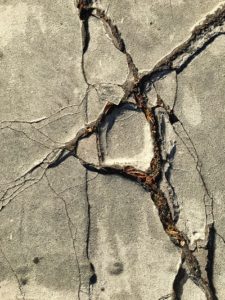As strong as concrete is, it’s still vulnerable to erosion. Weather, quality of the

Weather, quality of the construction, and other reasons can cause the concrete infrastructure to become weak and fail. Here’s everything you need to know about concrete erosion.
construction, and other reasons can cause the concrete infrastructure to become weak and fail. Here’s everything you need to know about concrete erosion.
Steel Corrosion
Cold climates tend to exacerbate the failing condition of steel in concrete reinforcements. This is one of the most difficult situations to find and repair because, without a change in weather conditions, the steel will continue to eventually wear away. Without proper protection from the elements, the concrete structure will become brittle and unsafe.
Sulfates
When water that contains a high concentration of dissolved sulfates comes into contact with concrete, it will seep into the structure of the concrete, crystallize, and expand. This disrupts the structure and integrity in the strength of the concrete. Sulfates will also react with the cement paste, causing it to dissolve and erode. The third way that sulfates cause concrete to erode is attributed to high curing temperatures in precast concrete.
Delamination
During the finishing process, if air or water gets trapped just below the surface of the concrete, the strength of the concrete will decrease. This will lead to a weakened horizontal plane across that particular area of the concrete. It usually happens when a professional applies a finish to the slab before the bleed water can reach the surface.
Freeze-Thaw
Every time concrete becomes saturated with moisture during freezing weather it endures pressure – this causes micro-cracking. Known as hydraulic pressure, over time the concrete will start to crumble and expose the aggregate. In cases when this issue isn’t immediately resolved, the entire concrete structure will eventually completely erode and disintegrate.
Alkali-Silica
In some cases, a reaction of alkali-silica will cause the concrete to crack. It happens when silica-containing aggregates react and form an expansive gel, which usually creates a map-like pattern across the surface of the concrete. You’ll notice this reaction by the gray or white gel on the surface or inside the voids.
Choose Concrete Visions for All Your GPR Needs!
Concrete Visions has over 12 years of experience and expertise in concrete scanning and we know how to detect any problems lurking beneath the surface. We use ground penetrating radar accurately and expertly and are familiar with many other methods that can be used when appropriate like concrete x-ray and electromagnetic conductivity. We are also very familiar with the latest construction safety techniques and train all of our workers to do their work quickly, accurately, and safely. If you would like to learn more about how we can help you, give us a call at (410) 766-2210 or visit us online. For more articles and tips, follow us on Facebook, Twitter, LinkedIn, and Google+.
